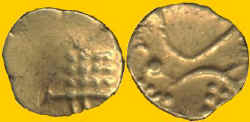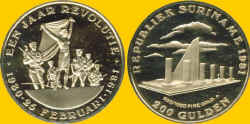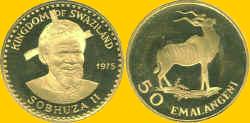This is the Worldwide Numismatics Website!
This is a modest collection of second millennium gold coins
Click the thumbnail picture to see a larger version of the picture, then use your browser BACK button to return to the original page you were viewing.
SOVEREIGN MILITARY ORDER OF MALTA
The Sovereign Military and Hospitaller Order of St John of Jerusalem, called of Rhodes, called of Malta (generally known as the Order of Malta), came into existence between c. 1080 when a hospital for pilgrims was established in Jerusalem near the Abbey of St Mary of the Latins, and 1113, when the hospital, its administrators and dependencies were recognized by the Pope as an Order of the Church, dedicated to the care of the sick poor. Half a century after its foundation it assumed military as well as hospitaller functions, and by 1200 it was playing a major role in the defence of the Christian settlements in Palestine and Syria which had been set up by the Crusaders. From its origins it was endowed on a massive scale in Western Europe and it developed an international structure to manage these properties for the benefit of its work in the East. Driven from Palestine with the rest of the Catholics in 1291, the Hospitallers of St John took over the island of Rhodes, off the coast of Asia Minor, which became their base for naval operations against Muslim shipping. They ruled the island as a semi-independent state until 1522. They were then given the island of Malta, which they held until 1798. During the centuries of the Order's government of Rhodes and Malta it became recognized as a sovereign power. With the loss of Malta the order's military functions ceased, and hospitaller work again became its only duty. It moved its headquarters to Rome in 1834. It is still regarded by many states (though not by all) as a sovereign subject of international public law. The seat of the Grand Magistracy in Rome, under the present Grand Master, HMEH Fra´ Andrew Bertie, has the right of extra-territoriality recognised by the Italian state.
1 Sovereign - 1970
KM-M039
- 8,05 g
This medallic issue was minted by the Sovereign Military Order of Malta which is headquartered in Rome, Italy. Several nations recognize the sovereignty of the Order. The obverse features the bust Grand Master Fr. Angelo di Mojana dei signori di Cologna (b1905-d1988) with the date 1970 below the bust. The reverse has the Order's arms encircled at the top by the Italian legend SOVRANO MILITARE ORDINE DI MALTA and at the bottom by the denomination SOVRANA.
SPAIN
The Romans arrived in the 3rd century BC but took two centuries to subdue the peninsula. Gradually Roman laws, languages and customs were adopted. In 409 AD, Roman Hispania was invaded by a massive contingent of Germanic tribes and by 419 a Visigoth kingdom had been established. The Visigoths ruled until 711, when the Muslims crossed the Strait of Gibraltar and defeated Roderick, the last Goth king. By 714, the Muslim armies had occupied the entire peninsula, apart from the mountainous regions of northern Spain. The Muslim occupation of southern Spain (which the Spanish called Al-Andalus) was to last almost 800 years. In 722, at Covadonga in northern Spain, a small army under the Visigoth king Pelayo inflicted the first defeat on the Muslims. Symbolically, this battle marked the beginning of the Reconquista, the reconquest of Spain by the Christians. By the end of the 13th century, Castilla and Aragón had emerged as Christian Spain's two main powers, and in 1469 these two kingdoms were united by the marriage of Isabel, princess of Castilla, to Fernando, heir to the throne of Aragón. Known as the Catholic Monarchs, they united all of Spain. In 1482, they besieged Granada, and 10 years later the last Muslim king surrendered to them, marking the long-awaited end of the Reconquista. Spain developed an enormous empire in the New World, following Columbus' arrival in the Americas in 1492. There were a number of expensive wars with England, France and the Netherlands. When Louis XVI was guillotined in 1793, Spain declared war on the new French republic, but was defeated. In 1808, Napoleon's troops entered Spain. Sparked by an uprising in Madrid, the Spanish people united against the French and fought a five-year war of independence. In 1813, the French forces were finally expelled, and in 1814 Fernando VII was restored to the Spanish throne. The disastrous Spanish-American War of 1898 marked the end of the Spanish Empire. In 1923, with the country on the brink of civil war, Miguel Primo de Rivera declared himself military dictator and ruled until 1930. In 1931, Alfonso XIII fled the country, and the Second Republic was declared, but it soon fell victim to internal conflict. The 1936 elections saw the country split in two, with the Republican government and its supporters on one side (an uneasy alliance of communists, socialists and anarchists, who favoured a diminished role for the Church) and the opposition Nationalists (a n anti-communist alliance of the army, the Church, the monarchy and the Falange Party) on the other. The assassination of the opposition leader José Calvo Sotelo by Republican police officers in July 1936 gave the army an excuse to overthrow the government. During the subsequent Civil War (1936-39), the Nationalists received extensive military and financial support from Nazi Germany and fascist Italy, while the elected Republican government received support only from communist Russia and, to a lesser degree, from the International Brigades, made up of foreign communists. By 1939, the Nationalists, led by Gen. Francisco Franco, had won the war. Franco died in 1975, having earlier named Juan Carlos, the grandson of Alfonso XIII, his successor. With Juan Carlos on the throne, Spain made the transition from dictatorship to democracy. The first elections were held in 1977, a new constitution was drafted in 1978, and a failed military coup in 1981 was seen as a futile attempt to turn back the clock. In 1982 Spain made a final break with the past by voting in a socialist government with a sizeable majority. In 1986 Spain joined the EC.
˝ Escudo - 1757-S--PJ
C-010.4
- 1,69 g
This historic very small coin was minted at the
Sevilla mint. The obverse features
a bareheaded bust of King Ferdinand VI (b1712-d1759) with the Latin legend
FERDINAND VI D G and the date. The
reverse has the royal coat of arms encircled by the Latin legend for SPANISH
KING. The S mintmark is at the bottom with the mintmasters' initials P J (for
Pedro Remillo Gordillo and Jose de Villaviciosa) on either side.
There are more Spanish gold coins in this section if you are interested - Page Spain 1
SRI LANKA
Sri Lanka's first settlers were the nomadic Veddahs. Buddhism was introduced in the 3rd century BC, and it quickly became the established religion and the focus of a strong nationalism. The Portuguese arrived in Colombo in 1505 and gained a monopoly on the invaluable spice trade. By 1597, the colonisers had taken formal control of the island. However, they failed to dislodge the powerful Sinhalese kingdom in Kandy which, in 1658, enlisted Dutch help to expel the Portuguese. The Dutch were more interested in trade and profits than religion or land, and only half-heartedly resisted when the British arrived in 1796. The British wore down Kandy's sovereignty and in 1815 became the first European power to rule the entire island. Coffee, tea, cinnamon and coconut plantations (worked by Tamil laborers imported from southern India) sprang up and English was introduced as the national language.
Then known as Ceylon, Sri Lanka finally achieved full independence in 1948. The government adopted socialist policies, but promoted Sinhalese interests, making Sinhalese the national language. It prompted the Tamil Hindu minority to press for greater autonomy in the main Tamil areas in the north and east. Ethnic and religious conflicts escalated as competition for wealth and work intensified. A Maoist revolt in 1971 led to the death of thousands. One year later, the country became a republic and made Sri Lanka its official name.
Fanam - ca1880
? - 0,36 g - 8 mm
The obverse features an arc and other geometric figures that represent a stylised massa standing figure. The reverse represents a stylised seated figure. This coin was minted in Kotte. The design is the Malabar Vira Raya fanam. The fanam was a tiny gold coin that circulated in Sri Lanka and South India from the 14th until the late 19th century.
SURINAME
The territory of present-day
Surinam formally changed hands many times between the Dutch, English and French,
before finally being confirmed as a Dutch possession by the terms of the 1815
Treaty of Vienna. At this time, the majority of the population were slaves,
working on the plantations. Despite the abolition of slavery in 1863, conditions
changed very little until the early-20th century. The discovery of large
bauxite deposits moved the territory into modern times.
In 1954 became an autonomous region within the Kingdom of The Netherlands. Full
independence was achieved in 1975. The new country’s political parties were
largely organised along ethnic lines – descendants of the black slave
workforce, Indonesians, Indians, mixed-race Creoles and a small
European contingent. The country after independence became politically unstable
which led to civil disorder and government changes.
200
Gulden - 1981
KM-020 - 7,12 g - 25.8 mm
Edge - Reeded
Mintage - 0,011M
This NCLT coin was issued to commemorate the first anniversary of the revolution whereby Suriname gained her independ3ence from The Netherlands.
SWAZILAND
The early Swazi probably moved
into the Mozambique area from the north sometime before to the 16th century.
Zulu attacks on them in the early 19th century, caused them to migrate to the
area of present-day Swaziland. Swaziland became a protectorate of the Boer
republic of The Transvaal in 1894. In 1906, Swaziland became a High Commission
Territory under a British commissioner. Swaziland was granted limited
self-government in 1963, and four years later Swaziland became a kingdom under a
new constitution. On Sept. 6, 1968, Swaziland achieved complete independence but
retained membership in the Commonwealth of Nations. The king became the head of
state, administering through a cabinet and a prime minister chosen by
parliament.
50 Emalangeni - 1975
KM-026 - 4,31 g - 20 mm
Edge - Reeded
Mintage - 3,262
The obverse has a bust of King Sobhuza II (b1899-d1982) with the country's name at the top and the king's name at the bottom. The reverse has an antelope with the denomination 50 EMALANGENI at the bottom.
If you would like to see additional gold coins, please click here - Page 31
If you want to return to the home page, please click here - Home



